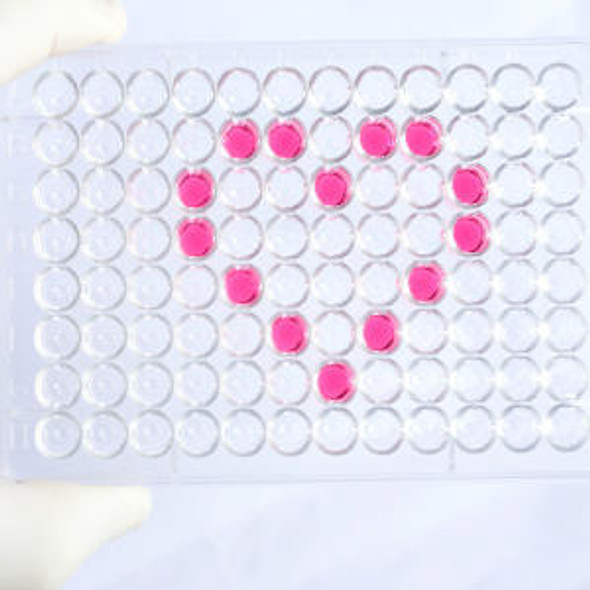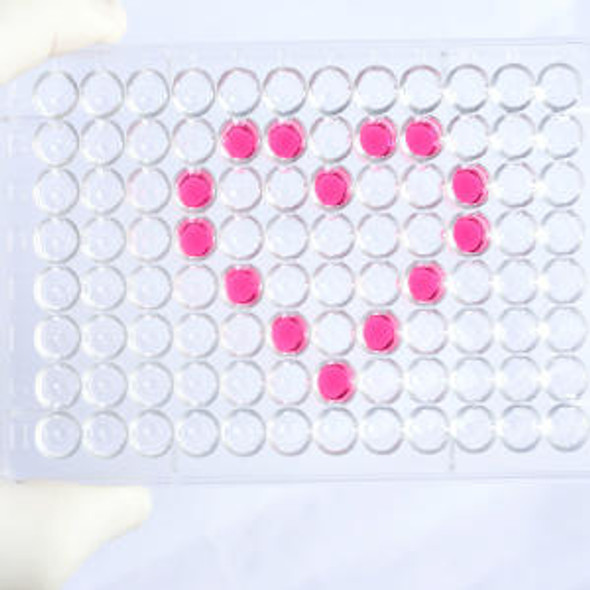Human Hyaluronidase-2 / HYAL2 ELISA Kit
- SKU:
- HUFI01015
- Product Type:
- ELISA Kit
- Size:
- 96 Assays
- Uniprot:
- Q12891
- Sensitivity:
- 0.188ng/ml
- Range:
- 0.313-20ng/ml
- ELISA Type:
- Sandwich ELISA, Double Antibody
- Synonyms:
- HYAL2, Hyaluronidase-2, Hyaluronoglucosaminidase-2, Lung carcinoma protein 2, LuCa-2, LUCA2, Hyal-2
- Reactivity:
- Human
Description
Human Hyaluronidase-2 / HYAL2 ELISA Kit
HYAL2 is linked to a variety of conditions, including Cleft Lip And Palate-Craniofacial Dysmorphism, Congenital Heart Defect, Hearing Loss Syndrome and Cor Triatriatum Sinister. Glycosaminoglycan metabolism is a pathway influenced by HYAL2. The Assay Genie Hyaluronidase-2/HYAL2 ELISA is a highly sensitive assay for the quantitative measurement of Hyaluronidase-2/HYAL2 in serum, blood, plasma, cell culture supernatant and tissue samples.
| Product Name: | Human Hyaluronidase-2 / HYAL2 ELISA Kit |
| Product Code: | HUFI01015 |
| Size: | 96 Assays |
| Alias: | HYAL2, Hyaluronidase-2, Hyaluronoglucosaminidase-2, Lung carcinoma protein 2, LuCa-2, LUCA2, Hyal-2 |
| Detection method: | Sandwich ELISA, Double Antibody |
| Application: | This immunoassay kit allows for the in vitro quantitative determination of Human HYAL2 concentrations in serum plasma and other biological fluids. |
| Sensitivity: | 0.188ng/ml |
| Range: | 0.313-20ng/ml |
| Storage: | 4°C for 6 months |
| Note: | For Research Use Only |
| Recovery: | Matrices listed below were spiked with certain level of Human HYAL2 and the recovery rates were calculated by comparing the measured value to the expected amount of Human HYAL2 in samples. | ||||||||||||||||
| |||||||||||||||||
| Linearity: | The linearity of the kit was assayed by testing samples spiked with appropriate concentration of Human HYAL2 and their serial dilutions. The results were demonstrated by the percentage of calculated concentration to the expected. | ||||||||||||||||
| |||||||||||||||||
| CV(%): | Intra-Assay: CV<8% Inter-Assay: CV<10% |
| Component | Quantity | Storage |
| ELISA Microplate (Dismountable) | 8×12 strips | 4°C for 6 months |
| Lyophilized Standard | 2 | 4°C/-20°C |
| Sample/Standard Dilution Buffer | 20ml | 4°C |
| Biotin-labeled Antibody(Concentrated) | 120ul | 4°C (Protect from light) |
| Antibody Dilution Buffer | 10ml | 4°C |
| HRP-Streptavidin Conjugate(SABC) | 120ul | 4°C (Protect from light) |
| SABC Dilution Buffer | 10ml | 4°C |
| TMB Substrate | 10ml | 4°C (Protect from light) |
| Stop Solution | 10ml | 4°C |
| Wash Buffer(25X) | 30ml | 4°C |
| Plate Sealer | 5 | - |
Other materials and equipment required:
- Microplate reader with 450 nm wavelength filter
- Multichannel Pipette, Pipette, microcentrifuge tubes and disposable pipette tips
- Incubator
- Deionized or distilled water
- Absorbent paper
- Buffer resevoir
| Uniprot | Q12891 |
| UniProt Protein Function: | HYAL2: Hydrolyzes high molecular weight hyaluronic acid to produce an intermediate-sized product which is further hydrolyzed by sperm hyaluronidase to give small oligosaccharides. Displays very low levels of activity. Associates with and negatively regulates MST1R. Belongs to the glycosyl hydrolase 56 family. |
| UniProt Protein Details: | Protein type:EC 3.2.1.35; Glycan Metabolism - glycosaminoglycan degradation; Membrane protein, GPI anchor; Hydrolase Chromosomal Location of Human Ortholog: 3p21.3 Cellular Component: microvillus; cell surface; endoplasmic reticulum; lysosome; cytoplasmic membrane-bound vesicle; cytosol; lipid raft; Golgi membrane; anchored to external side of plasma membrane; anchored to plasma membrane; endocytic vesicle; perinuclear region of cytoplasm; apical plasma membrane; cytoplasm; plasma membrane; cytoplasmic vesicle Molecular Function:viral receptor activity; receptor signaling protein tyrosine kinase inhibitor activity; protein binding; enzyme binding; transforming growth factor beta binding; hyaluronic acid binding; hyaluronoglucuronidase activity; receptor tyrosine kinase binding; hyalurononglucosaminidase activity Biological Process: negative regulation of MAP kinase activity; entry of virus into host cell; negative regulation of protein kinase B signaling cascade; glycosaminoglycan metabolic process; response to virus; multicellular organismal aging; pathogenesis; hyaluronan catabolic process; response to antibiotic; response to reactive oxygen species; glycosaminoglycan catabolic process; viral envelope fusion with host membrane; monocyte activation; positive regulation of protein import into nucleus; skeletal morphogenesis; cartilage development; carbohydrate metabolic process; hemopoietic progenitor cell differentiation; positive regulation of transcription from RNA polymerase II promoter; negative regulation of cell growth; kidney development; defense response to virus; hyaluronan metabolic process; positive regulation of inflammatory response; transformation of host cell by virus |
| NCBI Summary: | This gene encodes a weak acid-active hyaluronidase. The encoded protein is similar in structure to other more active hyaluronidases. Hyaluronidases degrade hyaluronan, one of the major glycosaminoglycans of the extracellular matrix. Hyaluronan and fragments of hyaluronan are thought to be involved in cell proliferation, migration and differentiation. Although it was previously thought to be a lysosomal hyaluronidase that is active at a pH below 4, the encoded protein is likely a GPI-anchored cell surface protein. This hyaluronidase serves as a receptor for the oncogenic virus Jaagsiekte sheep retrovirus. The gene is one of several related genes in a region of chromosome 3p21.3 associated with tumor suppression. This gene encodes two alternatively spliced transcript variants which differ only in the 5' UTR.[provided by RefSeq, Mar 2010] |
| UniProt Code: | Q12891 |
| NCBI GenInfo Identifier: | 311033483 |
| NCBI Gene ID: | 8692 |
| NCBI Accession: | Q12891.4 |
| UniProt Secondary Accession: | Q12891,O15177, Q9BW29, B3KRZ2, |
| UniProt Related Accession: | Q12891 |
| Molecular Weight: | 53,860 Da |
| NCBI Full Name: | Hyaluronidase-2 |
| NCBI Synonym Full Names: | hyaluronoglucosaminidase 2 |
| NCBI Official Symbol: | HYAL2 |
| NCBI Official Synonym Symbols: | LUCA2 |
| NCBI Protein Information: | hyaluronidase-2; hyal-2; PH20 homolog; PH-20 homolog; hyaluronidase 2; lysosomal hyaluronidase; lung carcinoma protein 2; hyaluronoglucosaminidase-2 |
| UniProt Protein Name: | Hyaluronidase-2 |
| UniProt Synonym Protein Names: | Hyaluronoglucosaminidase-2; Lung carcinoma protein 2; LuCa-2 |
| UniProt Gene Name: | HYAL2 |
| UniProt Entry Name: | HYAL2_HUMAN |
*Note: Protocols are specific to each batch/lot. For the correct instructions please follow the protocol included in your kit.
Before adding to wells, equilibrate the SABC working solution and TMB substrate for at least 30 min at 37°C. When diluting samples and reagents, they must be mixed completely and evenly. It is recommended to plot a standard curve for each test.
| Step | Protocol |
| 1. | Set standard, test sample and control (zero) wells on the pre-coated plate respectively, and then, record their positions. It is recommended to measure each standard and sample in duplicate. Wash plate 2 times before adding standard, sample and control (zero) wells! |
| 2. | Aliquot 0.1ml standard solutions into the standard wells. |
| 3. | Add 0.1 ml of Sample / Standard dilution buffer into the control (zero) well. |
| 4. | Add 0.1 ml of properly diluted sample ( Human serum, plasma, tissue homogenates and other biological fluids.) into test sample wells. |
| 5. | Seal the plate with a cover and incubate at 37 °C for 90 min. |
| 6. | Remove the cover and discard the plate content, clap the plate on the absorbent filter papers or other absorbent material. Do NOT let the wells completely dry at any time. Wash plate X2. |
| 7. | Add 0.1 ml of Biotin- detection antibody working solution into the above wells (standard, test sample & zero wells). Add the solution at the bottom of each well without touching the side wall. |
| 8. | Seal the plate with a cover and incubate at 37°C for 60 min. |
| 9. | Remove the cover, and wash plate 3 times with Wash buffer. Let wash buffer rest in wells for 1 min between each wash. |
| 10. | Add 0.1 ml of SABC working solution into each well, cover the plate and incubate at 37°C for 30 min. |
| 11. | Remove the cover and wash plate 5 times with Wash buffer, and each time let the wash buffer stay in the wells for 1-2 min. |
| 12. | Add 90 µl of TMB substrate into each well, cover the plate and incubate at 37°C in dark within 10-20 min. (Note: This incubation time is for reference use only, the optimal time should be determined by end user.) And the shades of blue can be seen in the first 3-4 wells (with most concentrated standard solutions), the other wells show no obvious color. |
| 13. | Add 50 µl of Stop solution into each well and mix thoroughly. The color changes into yellow immediately. |
| 14. | Read the O.D. absorbance at 450 nm in a microplate reader immediately after adding the stop solution. |
When carrying out an ELISA assay it is important to prepare your samples in order to achieve the best possible results. Below we have a list of procedures for the preparation of samples for different sample types.
| Sample Type | Protocol |
| Serum | If using serum separator tubes, allow samples to clot for 30 minutes at room temperature. Centrifuge for 10 minutes at 1,000x g. Collect the serum fraction and assay promptly or aliquot and store the samples at -80°C. Avoid multiple freeze-thaw cycles. If serum separator tubes are not being used, allow samples to clot overnight at 2-8°C. Centrifuge for 10 minutes at 1,000x g. Remove serum and assay promptly or aliquot and store the samples at -80°C. Avoid multiple freeze-thaw cycles. |
| Plasma | Collect plasma using EDTA or heparin as an anticoagulant. Centrifuge samples at 4°C for 15 mins at 1000 × g within 30 mins of collection. Collect the plasma fraction and assay promptly or aliquot and store the samples at -80°C. Avoid multiple freeze-thaw cycles. Note: Over haemolysed samples are not suitable for use with this kit. |
| Urine & Cerebrospinal Fluid | Collect the urine (mid-stream) in a sterile container, centrifuge for 20 mins at 2000-3000 rpm. Remove supernatant and assay immediately. If any precipitation is detected, repeat the centrifugation step. A similar protocol can be used for cerebrospinal fluid. |
| Cell culture supernatant | Collect the cell culture media by pipette, followed by centrifugation at 4°C for 20 mins at 1500 rpm. Collect the clear supernatant and assay immediately. |
| Cell lysates | Solubilize cells in lysis buffer and allow to sit on ice for 30 minutes. Centrifuge tubes at 14,000 x g for 5 minutes to remove insoluble material. Aliquot the supernatant into a new tube and discard the remaining whole cell extract. Quantify total protein concentration using a total protein assay. Assay immediately or aliquot and store at ≤ -20 °C. |
| Tissue homogenates | The preparation of tissue homogenates will vary depending upon tissue type. Rinse tissue with 1X PBS to remove excess blood & homogenize in 20ml of 1X PBS (including protease inhibitors) and store overnight at ≤ -20°C. Two freeze-thaw cycles are required to break the cell membranes. To further disrupt the cell membranes you can sonicate the samples. Centrifuge homogenates for 5 mins at 5000xg. Remove the supernatant and assay immediately or aliquot and store at -20°C or -80°C. |
| Tissue lysates | Rinse tissue with PBS, cut into 1-2 mm pieces, and homogenize with a tissue homogenizer in PBS. Add an equal volume of RIPA buffer containing protease inhibitors and lyse tissues at room temperature for 30 minutes with gentle agitation. Centrifuge to remove debris. Quantify total protein concentration using a total protein assay. Assay immediately or aliquot and store at ≤ -20 °C. |
| Breast Milk | Collect milk samples and centrifuge at 10,000 x g for 60 min at 4°C. Aliquot the supernatant and assay. For long term use, store samples at -80°C. Minimize freeze/thaw cycles. |










